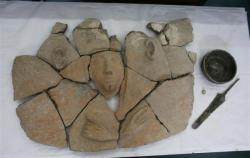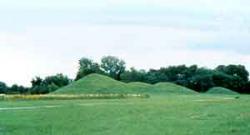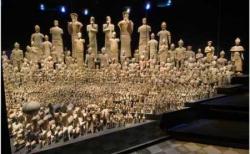INSTITUT SUPERIEUR D'ANTHROPOLOGIE
INSTITUTE OF ANTHROPOLOGY
ONLINE COURSES / COURS A DISTANCE
SUMMER TERM : JULY 2014
REGISTER NOW
ISRAEL –  Jezreel Valley - Archaeologists unveiled on Wednesday a 3,300-year-old coffin containing a signet ring bearing the name of an Egyptian pharaoh among the remains of what they believe was a local nobleman. The discovery last month in Israel's northern Jezreel Valley, was the first of its kind in the region in half a century and pointed to wide Egyptian influence during the late Bronze Age reign of Seti I, whose name was on the seal. The Israel Antiquities Authority said it had dated remains in the broken coffin - whose cover fragments clearly depict a human face, ears and hands - to the 13th century BC. The discovery was made last month during the digging of a gas pipeline. Archaeologist Ron Beeri, a member of the excavation team, said the presence of the seal suggested the remains were those of a wealthy Canaanite who may have collected taxes or performed other duties on behalf of ancient Egypt. "We can't rule out the possibility that it may simply be a wealthy person who knew the Egyptian burial customs and preferred to be buried like an Egyptian, but in my opinion this possibility is less likely," Beeri said. A bronze dagger and saucer, some hammered pieces of bronze and a number of clay vessels were found at the burial site, suggesting the deceased was an important figure in the local community. Seti I extended Egypt's sphere of influence through military campaigns in what is now northern Israel and Syria, and the Jezreel Valley was a main thoroughfare.
Jezreel Valley - Archaeologists unveiled on Wednesday a 3,300-year-old coffin containing a signet ring bearing the name of an Egyptian pharaoh among the remains of what they believe was a local nobleman. The discovery last month in Israel's northern Jezreel Valley, was the first of its kind in the region in half a century and pointed to wide Egyptian influence during the late Bronze Age reign of Seti I, whose name was on the seal. The Israel Antiquities Authority said it had dated remains in the broken coffin - whose cover fragments clearly depict a human face, ears and hands - to the 13th century BC. The discovery was made last month during the digging of a gas pipeline. Archaeologist Ron Beeri, a member of the excavation team, said the presence of the seal suggested the remains were those of a wealthy Canaanite who may have collected taxes or performed other duties on behalf of ancient Egypt. "We can't rule out the possibility that it may simply be a wealthy person who knew the Egyptian burial customs and preferred to be buried like an Egyptian, but in my opinion this possibility is less likely," Beeri said. A bronze dagger and saucer, some hammered pieces of bronze and a number of clay vessels were found at the burial site, suggesting the deceased was an important figure in the local community. Seti I extended Egypt's sphere of influence through military campaigns in what is now northern Israel and Syria, and the Jezreel Valley was a main thoroughfare.
http://uk.reuters.com/article/2014/04/09/us-israel-archaeology-idUKBREA3810V20140409
INDE - Gandhinagar -IIT Gandhinagar will soon get a new lab for carbon-dating which will be funded by The Archeological Survey of India (ASI). A centre for archeological science has already been set up in the institute and it will see a multi disciplinary approach to archeology, along with the establishment of a carbon-dating lab.
http://indiatoday.intoday.in/education/story/asi-to-fund-a-new-carbon-dating-lab-at-iit-gandhinagar/1/353717.html
USA –  Spiro Mounds - Archaeologists will return to an ancient Native American site in eastern Oklahoma next month to resume excavation, after they discovered a prehistoric building there last October.Few artifacts have been discovered near the formation — which measures just about 12 feet across — at Spiro Mounds making it difficult for researchers to determine the time period of the building, said Scott Hammerstedt, a researcher at the Oklahoma Archaeological Survey. "It's a building. A prehistoric building, a fairly faint one — but one nonetheless," he said. Researchers will head back to excavate a handful of other areas during five weeks of fieldwork in May and June, Hammerstedt said.Spiro Mounds is located about seven miles outside of Spiro. It became a permanent settlement around AD 800 and was used until about 1450, according to the Oklahoma Historical Society. In the 1930s, commercial and academic excavations revealed a large collection of Native American artifacts, many of which were looted from the site. "Almost all of what we know about Spiro comes from excavation of the Craig Mound in the 1930s — both by looters and by professional archaeologists. And we know next to nothing about what's happening in other parts of the site and around it, and so we're just sort of shifting focus away from mounds into the rest," Hammerstedt said. He said the current research work is the first excavation work at the site since 1982.
Spiro Mounds - Archaeologists will return to an ancient Native American site in eastern Oklahoma next month to resume excavation, after they discovered a prehistoric building there last October.Few artifacts have been discovered near the formation — which measures just about 12 feet across — at Spiro Mounds making it difficult for researchers to determine the time period of the building, said Scott Hammerstedt, a researcher at the Oklahoma Archaeological Survey. "It's a building. A prehistoric building, a fairly faint one — but one nonetheless," he said. Researchers will head back to excavate a handful of other areas during five weeks of fieldwork in May and June, Hammerstedt said.Spiro Mounds is located about seven miles outside of Spiro. It became a permanent settlement around AD 800 and was used until about 1450, according to the Oklahoma Historical Society. In the 1930s, commercial and academic excavations revealed a large collection of Native American artifacts, many of which were looted from the site. "Almost all of what we know about Spiro comes from excavation of the Craig Mound in the 1930s — both by looters and by professional archaeologists. And we know next to nothing about what's happening in other parts of the site and around it, and so we're just sort of shifting focus away from mounds into the rest," Hammerstedt said. He said the current research work is the first excavation work at the site since 1982.
http://www.tribtown.com/view/story/57342bd33aec4246be973a0f85a27364/OK--Spiro-Mounds-Excavation
CHYPRE –  Aya Irini - The sanctuary of Ayia Irini is arguably one of the most impressive discoveries of the Swedish Expedition in Cyprus (1927-1931). Reputed for its masses of terracotta votive statuary, Ayia Irini has produced one the richest corpora of figures and figurines ever to have been excavated in the ancient Mediterranean. However, in spite of its significance our knowledge of Ayia Irini’s history and archaeology is still insufficient, mainly due to two factors: The first one is related to the publication of the sanctuary that placed particular emphasis on the terracotta figures and figurines as opposed to other groups of material (especially pottery). The second factor has to do with the site’s inaccessibility by modern archaeological research. “The research project launched by Medelhavsmuseet in 2011 aims to shed light to some of these less known aspects of Ayia Irini’s history. Hosting the biggest collection of (properly excavated) Cypriot antiquities outside of Cyprus, Medelhavsmuseet offers an ideal environment for this kind of research. The project focuses on the pottery fragments produced during the Swedish expedition at Ayia Irini (over 100,000 sherds). This major corpus of evidence was kept in the museum’s storehouses unpublished and unstudied. The sorting, registration and full archaeological documentation of this material is expected to produce new evidence concerning the chronology, the phases and the cultic activity at Ayia Irini.
Aya Irini - The sanctuary of Ayia Irini is arguably one of the most impressive discoveries of the Swedish Expedition in Cyprus (1927-1931). Reputed for its masses of terracotta votive statuary, Ayia Irini has produced one the richest corpora of figures and figurines ever to have been excavated in the ancient Mediterranean. However, in spite of its significance our knowledge of Ayia Irini’s history and archaeology is still insufficient, mainly due to two factors: The first one is related to the publication of the sanctuary that placed particular emphasis on the terracotta figures and figurines as opposed to other groups of material (especially pottery). The second factor has to do with the site’s inaccessibility by modern archaeological research. “The research project launched by Medelhavsmuseet in 2011 aims to shed light to some of these less known aspects of Ayia Irini’s history. Hosting the biggest collection of (properly excavated) Cypriot antiquities outside of Cyprus, Medelhavsmuseet offers an ideal environment for this kind of research. The project focuses on the pottery fragments produced during the Swedish expedition at Ayia Irini (over 100,000 sherds). This major corpus of evidence was kept in the museum’s storehouses unpublished and unstudied. The sorting, registration and full archaeological documentation of this material is expected to produce new evidence concerning the chronology, the phases and the cultic activity at Ayia Irini.
http://www.archaiologia.gr/en/blog/2014/04/09/the-ayia-irini-sanctuary-in-cyprus/
ROYAUME UNI - Cambuskenneth - A 700-year-old English coin has been found near the abbey where the victorious Robert the Bruce took booty from the Battle of Bannockburn.The silver penny was discovered yards from Cambuskenneth Abbey, near Stirling, by archaeologists looking for artefacts from the time of the 1314 battle. The small coin, minted in London during the late 13th or early 14th century, may have been a month’s wages for a soldier in Edward II’s defeated army. Experts from GUARD Archaeology, who led a metal detector survey of the area, believe it may have been among the spoils of battle taken back to the abbey by the Bruce from the battlefield. Warren Bailie, GUARD’s battlefield archaeologist, who led the search, said today: “This coin would have been in circulation in 1314 and could relate to the Battle of Bannockburn. “Cambuskenneth Abbey was where the Scots’ baggage train was held before the battle and where they returned to immediately afterwards. “It was where the booty was taken from the battlefield, so it could potentially have been dropped booty. “It was worth quite a lot of money at that time -- perhaps a soldier’s wage for that month.” Cambuskenneth Abbey is one of the few places specifically mentioned in near contemporary accounts of the Battle of Bannockburn. Robert the Bruce kept his army’s baggage there prior to the battle, and it was the location for a series of parliaments during his rule. The first, in November 1314, just a few months after the historic victory, saw Robert disinherit all the nobles holding lands in Scotland who were not present; including the sons of those who had died fighting for Edward II at Bannockburn. The worn coin was found in topsoil just 3cm down. It will now undergo analysis to help determine its exact origin.
http://www.scotsman.com/lifestyle/heritage/700-year-old-coin-found-during-bannockburn-dig-1-3371112